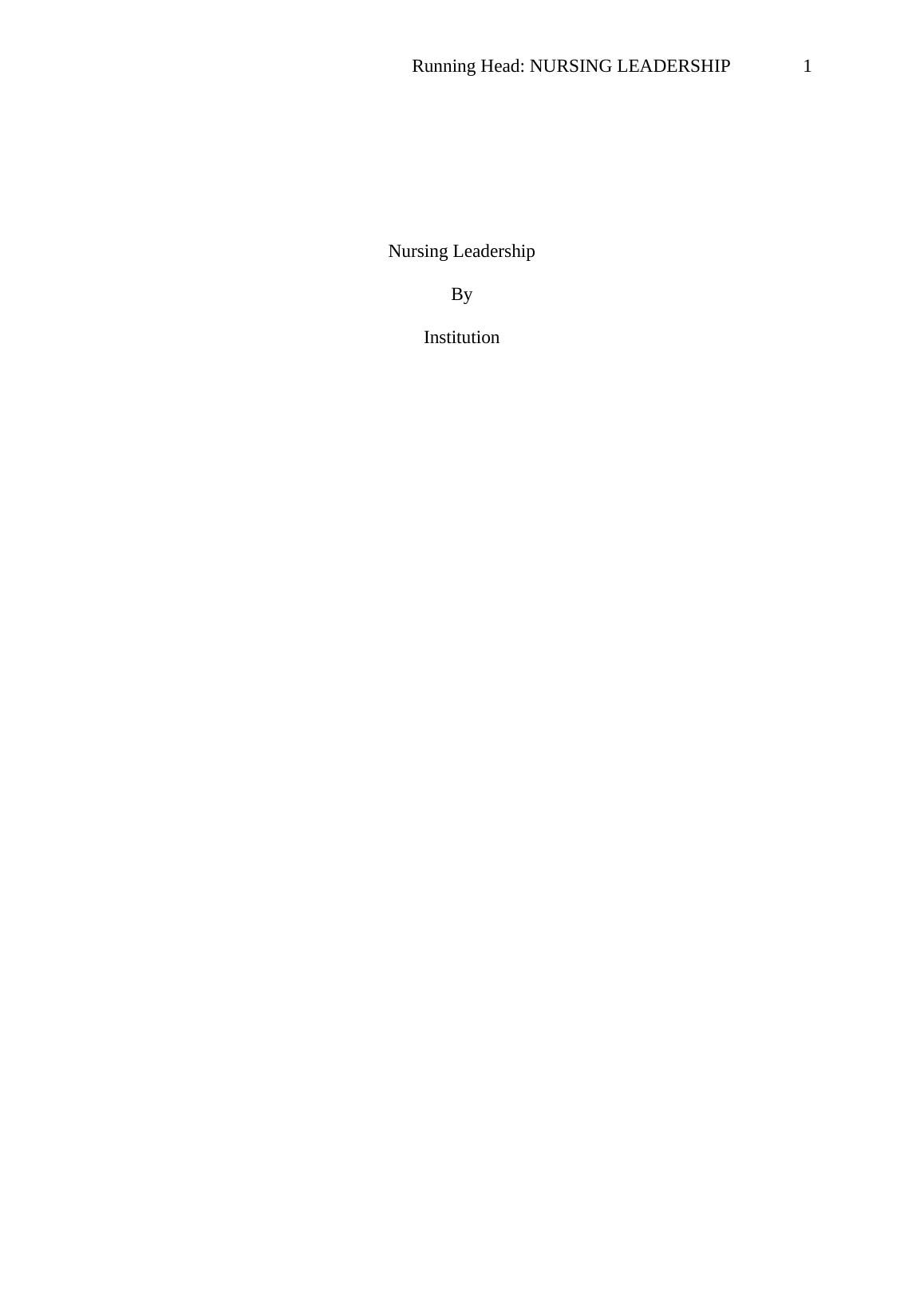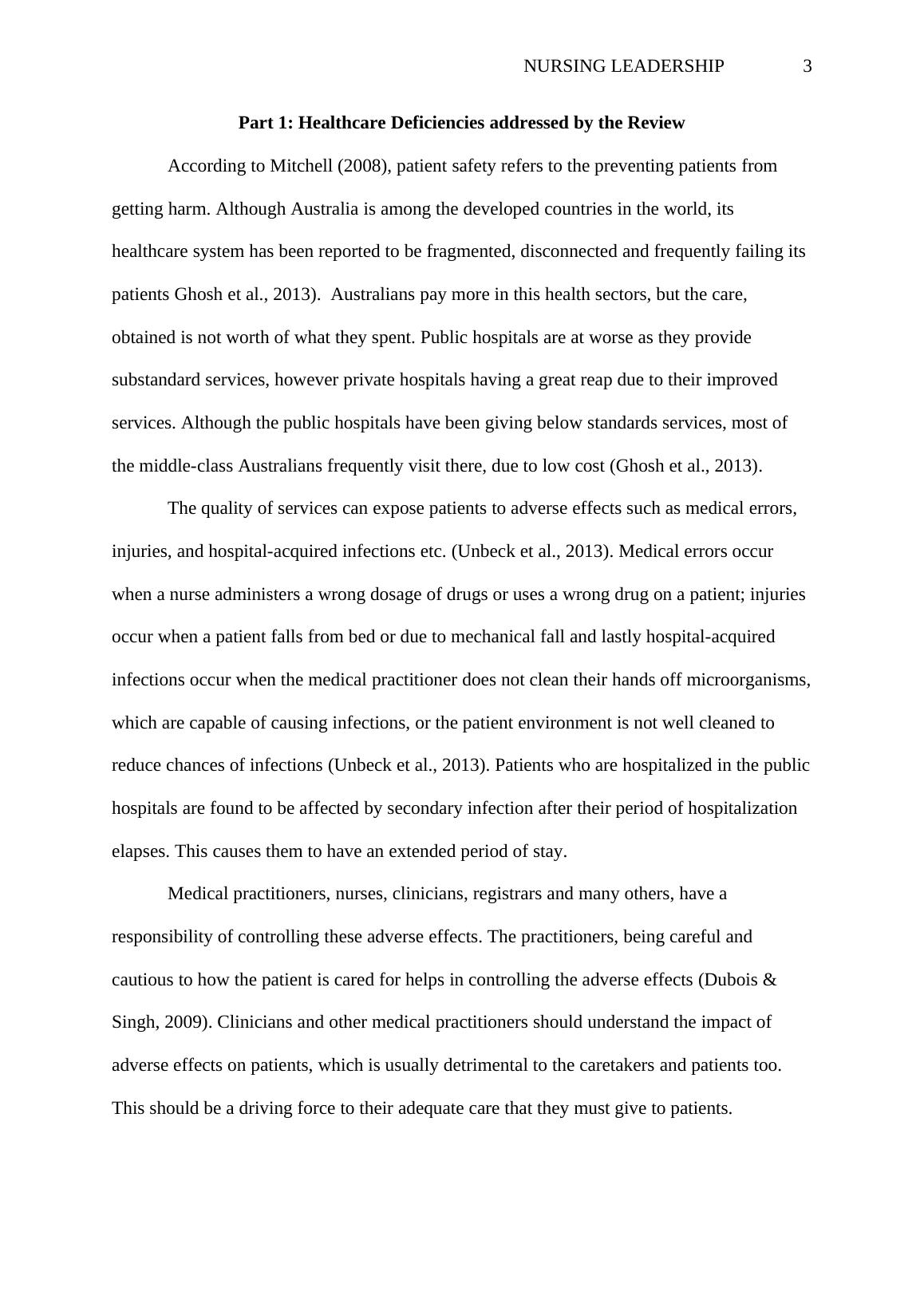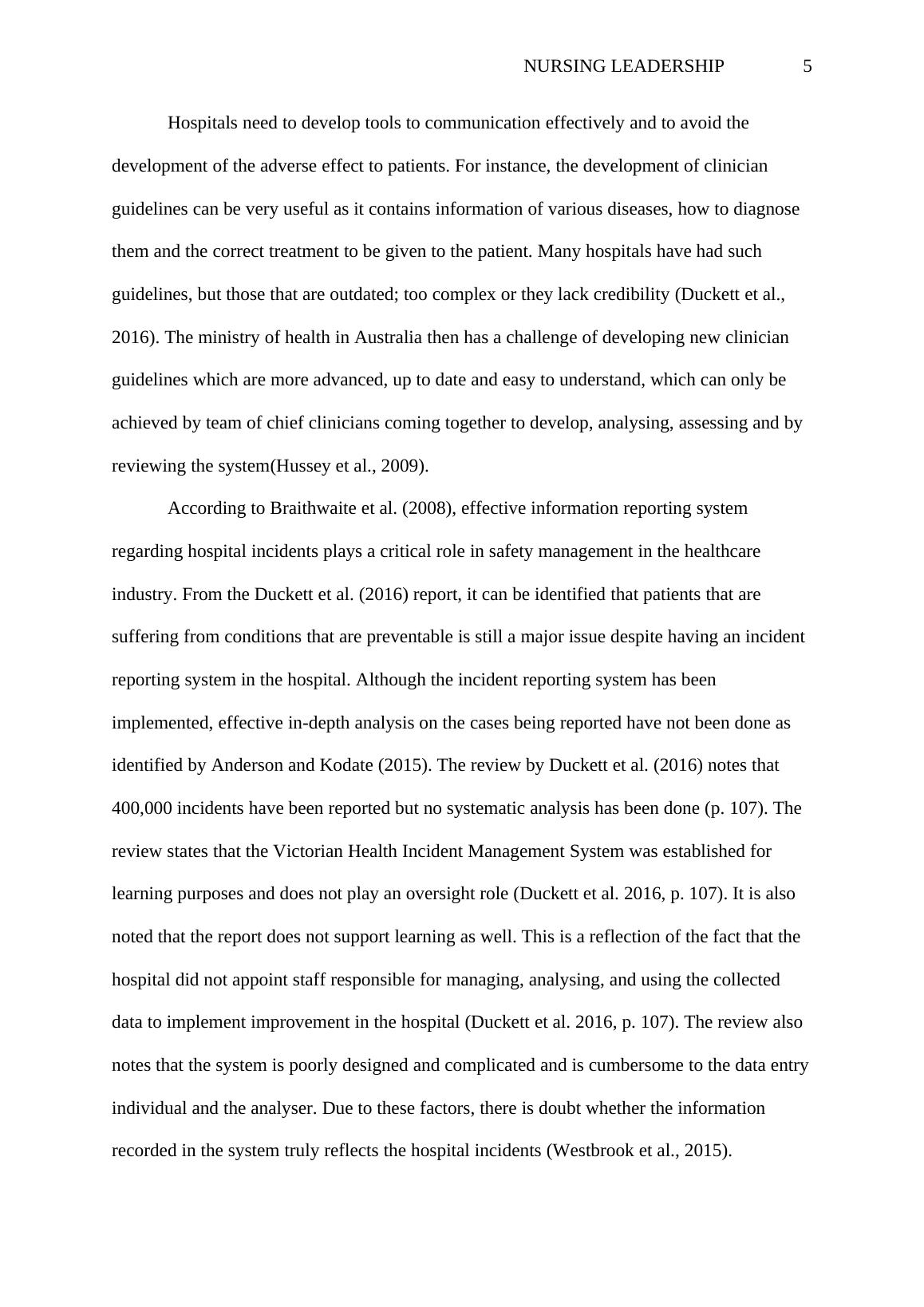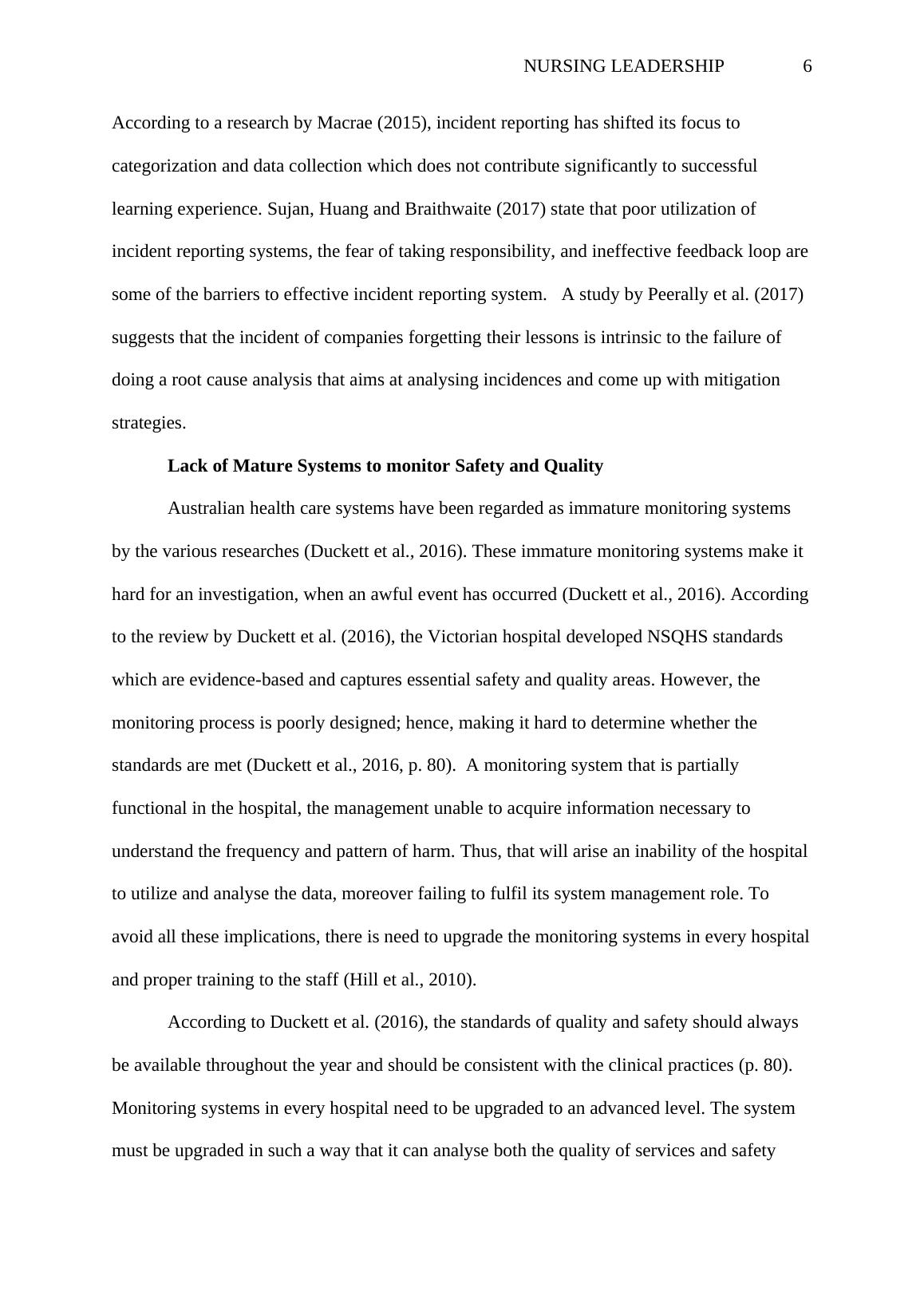Nursing Leadership in Australia: Assignment
Added on 2020-04-01
21 Pages6732 Words51 Views
Running Head: NURSING LEADERSHIP1Nursing LeadershipByInstitution

NURSING LEADERSHIP2AbstractHealthcare facilities aim to provide quality services to patients in Australia. Although some patients are satisfied with the quality of service being provided by hospitals however most of them are not satisfied due to lot of deficiencies in this sector which leads to poor service provision. Among the deficiencies are poor monitoring services, information deficiencies, some board members lacking the capability to monitor the system and inconsistent excellence(Duckett, Cuddihy, & Newnham, 2016).Those identified deficiencies are related to the standards, established by the National Quality and Safety Services standards. Some of the standards in relation to this are National governance and quality provision, a partnership with consumers, medical safety and acknowledging and providing response to clinical deterioration in acute health care (Australian Commission on Safety and Quality Health Care, 2012).

NURSING LEADERSHIP3Part 1: Healthcare Deficiencies addressed by the ReviewAccording to Mitchell (2008), patient safety refers to the preventing patients from getting harm. Although Australia is among the developed countries in the world, its healthcare system has been reported to be fragmented, disconnected and frequently failing its patients Ghosh et al., 2013). Australians pay more in this health sectors, but the care, obtained is not worth of what they spent. Public hospitals are at worse as they provide substandard services, however private hospitals having a great reap due to their improved services. Although the public hospitals have been giving below standards services, most of the middle-class Australians frequently visit there, due to low cost (Ghosh et al., 2013). The quality of services can expose patients to adverse effects such as medical errors, injuries, and hospital-acquired infections etc. (Unbeck et al., 2013). Medical errors occur when a nurse administers a wrong dosage of drugs or uses a wrong drug on a patient; injuries occur when a patient falls from bed or due to mechanical fall and lastly hospital-acquired infections occur when the medical practitioner does not clean their hands off microorganisms,which are capable of causing infections, or the patient environment is not well cleaned to reduce chances of infections (Unbeck et al., 2013). Patients who are hospitalized in the publichospitals are found to be affected by secondary infection after their period of hospitalization elapses. This causes them to have an extended period of stay.Medical practitioners, nurses, clinicians, registrars and many others, have a responsibility of controlling these adverse effects. The practitioners, being careful and cautious to how the patient is cared for helps in controlling the adverse effects (Dubois & Singh, 2009). Clinicians and other medical practitioners should understand the impact of adverse effects on patients, which is usually detrimental to the caretakers and patients too. This should be a driving force to their adequate care that they must give to patients.

NURSING LEADERSHIP4System managers together with policymakers have a responsibility to reduce the impact of adverse effects. They have a responsibility as leaders to help hospitals benchmark against each other, to give incentives to clinicians and nurses which will help them prioritize and put more effort on the safe care provided to patients (Dubois & Singh, 2009). Without thehelp of leaders, it will be difficult for the health practitioners to penetrate and give the safe care required due to lack of information, resources, and incentives. The adverse effects experienced in most of the hospitals are attributed to various factors. These are the healthcare deficiencies. They explain what is not done right in the hospital system leading to the increased adverse effects. From the review, the following are some of the healthcare deficiencies that were identified. Healthcare Deficiencies From the review by Duckett et al. (2016), there are various healthcare deficiencies that are experienced in the Australian healthcare facilities, especially in the public hospitals. Among these healthcare deficiencies mentioned in the review are: Hospitals cannot access critical information, lack of mature systems monitoring safety and quality, some boards do not have the necessary capability to monitor the safety and quality of their hospitals; instead, the hospital is capitalised with pockets of excellence and not consistent excellence (Duckett et al., 2016). Lack of Effective Incident Reporting Systems Information is a key element in hospitals that have an aim of providing safety and quality of services. Lack of information to both the clinicians and the entire hospital may leadto conflicts and medication error (Hussey et al., 2009). Due to lack of information serious issues such as overdosing, wrong medication administration and wrong treatment to the patient can occur. So, communication need to address properly (Hussey et al., 2009).

NURSING LEADERSHIP5Hospitals need to develop tools to communication effectively and to avoid the development of the adverse effect to patients. For instance, the development of clinician guidelines can be very useful as it contains information of various diseases, how to diagnose them and the correct treatment to be given to the patient. Many hospitals have had such guidelines, but those that are outdated; too complex or they lack credibility (Duckett et al., 2016). The ministry of health in Australia then has a challenge of developing new clinician guidelines which are more advanced, up to date and easy to understand, which can only be achieved by team of chief clinicians coming together to develop, analysing, assessing and by reviewing the system(Hussey et al., 2009).According to Braithwaite et al. (2008), effective information reporting system regarding hospital incidents plays a critical role in safety management in the healthcare industry. From the Duckett et al. (2016) report, it can be identified that patients that are suffering from conditions that are preventable is still a major issue despite having an incident reporting system in the hospital. Although the incident reporting system has been implemented, effective in-depth analysis on the cases being reported have not been done as identified by Anderson and Kodate (2015). The review by Duckett et al. (2016) notes that 400,000 incidents have been reported but no systematic analysis has been done (p. 107). The review states that the Victorian Health Incident Management System was established for learning purposes and does not play an oversight role (Duckett et al. 2016, p. 107). It is also noted that the report does not support learning as well. This is a reflection of the fact that the hospital did not appoint staff responsible for managing, analysing, and using the collected data to implement improvement in the hospital (Duckett et al. 2016, p. 107). The review also notes that the system is poorly designed and complicated and is cumbersome to the data entryindividual and the analyser. Due to these factors, there is doubt whether the information recorded in the system truly reflects the hospital incidents (Westbrook et al., 2015).

NURSING LEADERSHIP6According to a research by Macrae (2015), incident reporting has shifted its focus to categorization and data collection which does not contribute significantly to successful learning experience. Sujan, Huang and Braithwaite (2017) state that poor utilization of incident reporting systems, the fear of taking responsibility, and ineffective feedback loop aresome of the barriers to effective incident reporting system. A study by Peerally et al. (2017) suggests that the incident of companies forgetting their lessons is intrinsic to the failure of doing a root cause analysis that aims at analysing incidences and come up with mitigation strategies. Lack of Mature Systems to monitor Safety and QualityAustralian health care systems have been regarded as immature monitoring systems by the various researches (Duckett et al., 2016). These immature monitoring systems make it hard for an investigation, when an awful event has occurred (Duckett et al., 2016). Accordingto the review by Duckett et al. (2016), the Victorian hospital developed NSQHS standards which are evidence-based and captures essential safety and quality areas. However, the monitoring process is poorly designed; hence, making it hard to determine whether the standards are met (Duckett et al., 2016, p. 80). A monitoring system that is partially functional in the hospital, the management unable to acquire information necessary to understand the frequency and pattern of harm. Thus, that will arise an inability of the hospitalto utilize and analyse the data, moreover failing to fulfil its system management role. To avoid all these implications, there is need to upgrade the monitoring systems in every hospitaland proper training to the staff (Hill et al., 2010). According to Duckett et al. (2016), the standards of quality and safety should always be available throughout the year and should be consistent with the clinical practices (p. 80). Monitoring systems in every hospital need to be upgraded to an advanced level. The system must be upgraded in such a way that it can analyse both the quality of services and safety

End of preview
Want to access all the pages? Upload your documents or become a member.
Related Documents
(PDF) Quality and Safety in Health Care Managementlg...
|11
|2857
|23
NSG3NCR Nursing Reflective Clinical Practicelg...
|17
|4082
|349
Change Management Essay - Nursing Leadership and Managementlg...
|24
|7455
|77
Healthcare Quality Management Assessment 2022lg...
|14
|3193
|9
Safety Using in Nursing Research 2022lg...
|7
|1594
|13
Medication Safety: Causes, Effects, Strategies and Nursing Roleslg...
|7
|1518
|139